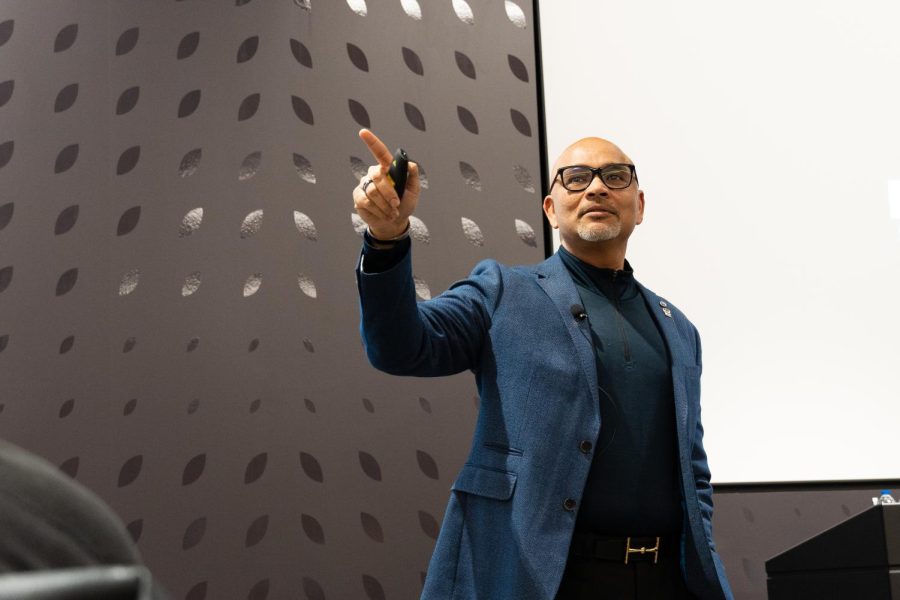CEO of Banyan Technologies Group delivers keynote speech on automobile mobility
Tanvir Arfi speaks on the future of automobile mobility. The CEO speculated that electric vehicles will become more popular with general consumers, within the next decade on Feb. 16.
In 1995, Tanvir Arfi graduated with a master’s degree from the College of Engineering. Now, he’s the founder, chairman, and CEO of Banyan Technologies Group, an enterprise platform that is largely business-to-business (B2B) services and software.
Arfi had led large trading companies and earned different certifications. He also serves on several industry boards such as the nation’s leading autism education and therapy provider, Aces.
Arfi is an auto enthusiast, owning cars such as one from the 60s American Muscle collection and a Harley rider, among others.
“The vast majority of U.S. households, a car purchase is the second largest asset that they will purchase, home being the first,” Arfi said. “But when you compare the two, the car is an incredibly underutilized asset.”
Arfi believes the car is freedom of mobility.
“I can go out, I can get in it, and I can get anywhere I want,” Arfi said.
Arfi joined students, faculty and staff in the Woolsey Hall auditorium for his keynote on the “Future of Human Mobility: Electric Vehicles, Autonomous Vehicles and Emerging Technologies,” on Feb. 16. In his presentation, he covered megatrends in mobility but focused on three — electric, autonomous and consumer behavior.
Arfi said his presentation consists of mostly first-hand information and is data-driven. The data comes from over 135 e-commerce websites that one of his subsidiaries runs today, over 250 million emails and 52 million texts exchanged with consumers and over 240 million impressions of digital service information that is spread out from 150,000 franchises.
To make the presentation interactive, he called out questions and whoever answered correctly or close would receive a card that they then could redeem at a table in the atrium.
Consumer behavior
“How many of you don’t have your phone with you right now?” Afri asked those in Woolsey Hall.
No one in the audience raised their hand.
Afri said that our lives are tied to digital services and provided numbers from sites such as YouTube, Twitter and Amazon.
“Why would car buying, car ownership and car services not be digital?” Afri asked.
Afri said you can buy and sell your car 100% online on your phone right now, and you will get a better deal than at a car dealership.
Afri emphasized the use of reward programs and anticipating customers’ needs.
“Every Ford Bronco that is sold in the country, my group gets the VIN number,” Afri said. “The VIN number is a 17-digit number, which is a unique locator of the bill of material of that vehicle. And it provides information all the way down to every system of the car to the color of the car and whether you got under code protection.”
Because of this, Afri’s company can anticipate what you need before you need it. Such as, buying a cover you might need for when you take the top off of your car, as the company can see you bought a car with that ability.
“If you don’t think this is going to be far more transformative in the future, you will see, you will see it coming,” Alfri said.
Autonomous Vehicles
Alfri talked about autonomous cars, vehicles that drive themselves.
These vehicles have intricate systems that allow them to function properly.
“The sensors are providing information to the electronic control modules, the electronic control module is processing it, the AI is making decisions, and then the control system is moving the car around,” Alfri said.
Alfri showed a video of an autonomous vehicle being used in Austin, Texas. The vehicle was essentially being used like Uber Eats.
Electric Vehicles
Alfri explained how electric vehicles are built to look like the average car.
He showed photos of different cars throughout history.
“At the end of the day, if I was an alien landing on Earth. I will look at this (car) from 100 years ago and this (car) from 100 years later. Is it fundamentally that different?” Alfri said. “The basic design of what a car looks like hasn’t really changed in 80 years.”

Jaycie Nelson was the editor-in-chief for The Sunflower during the 2022-2023 academic year. Before becoming editor, Nelson was opinion editor.










